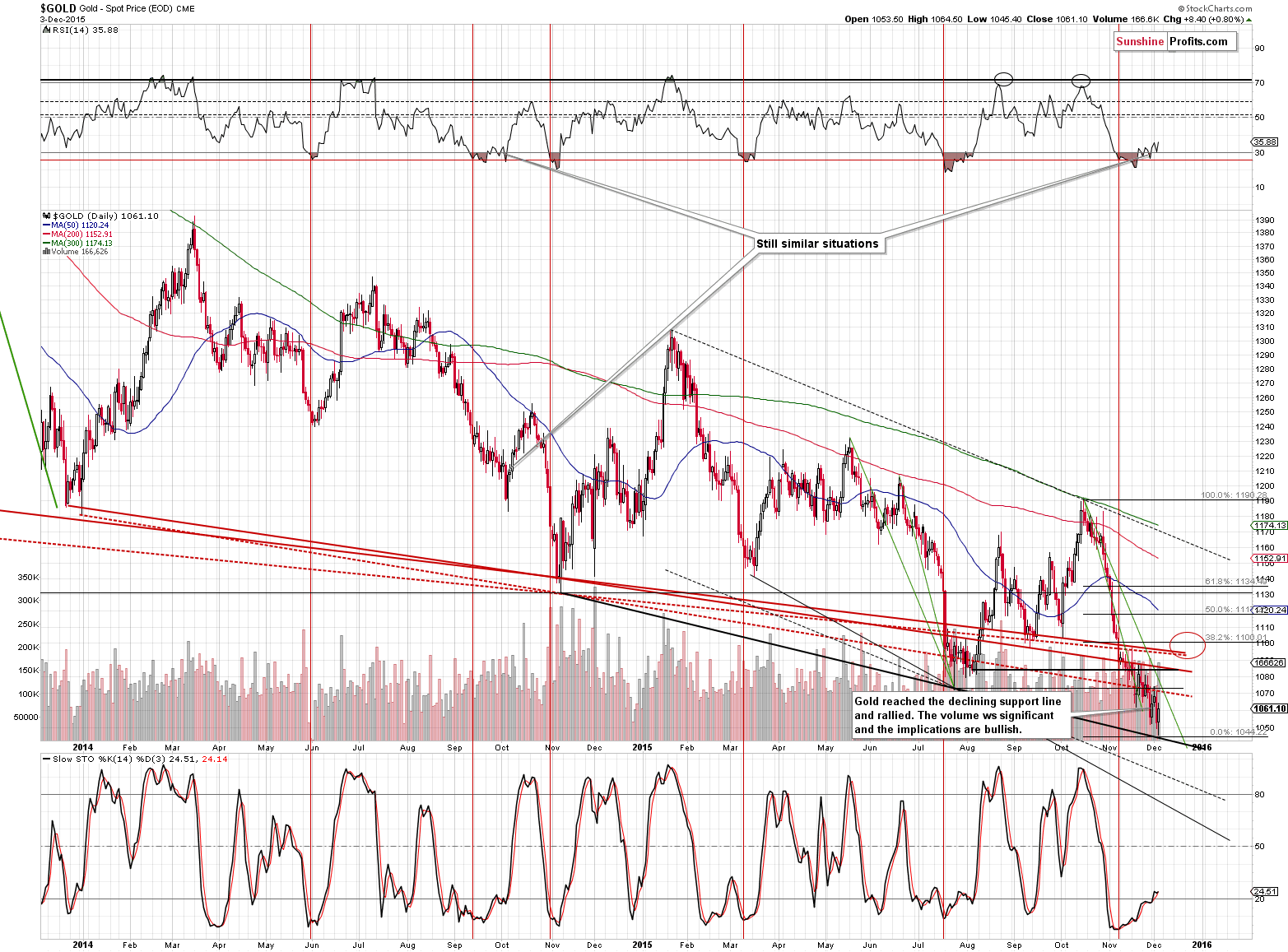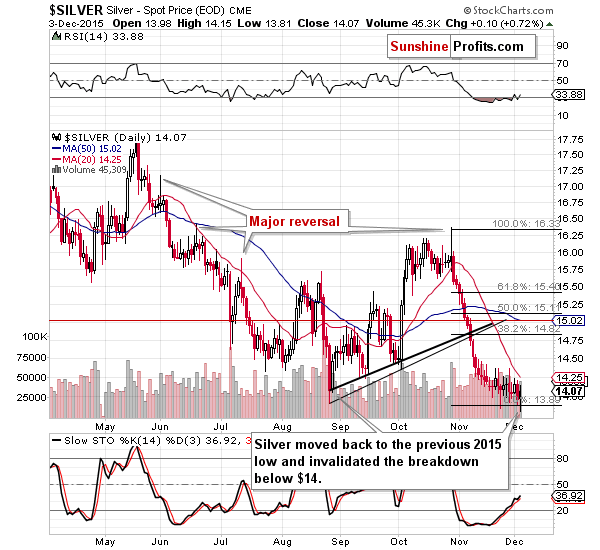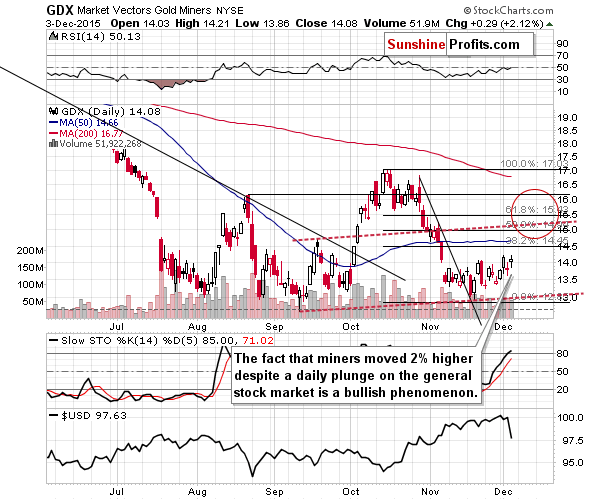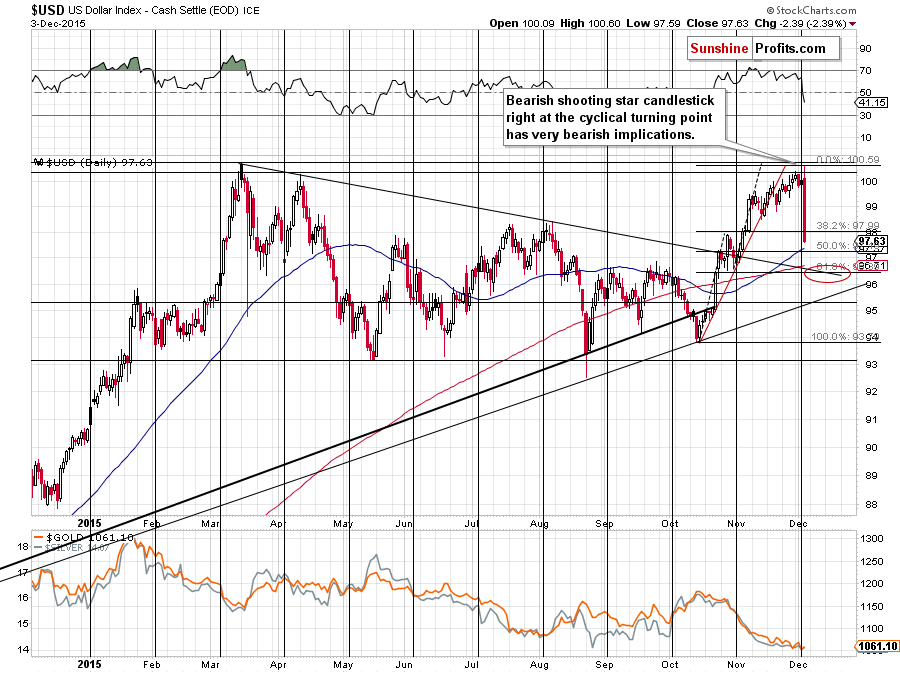Briefly: In our opinion, long (half) speculative positions in gold, silver and mining stocks are justified from the risk/reward point of view.
The USD Index plunged yesterday right after a cyclical turning point and after comments from the ECB. Gold, however, didn’t soar as much. It closed higher, but the size of the move was much smaller than the one in the USD Index. Is gold’s lack of a major rally a bearish phenomenon?
Not necessarily. The USD Index dropped not because the USD itself became hated – it declined because the euro was valued more. Consequently, it’s not really an important bearish factor that gold moved just a little higher as it’s not really the case that gold didn’t respond to the USD’s weakness – it was actually the EUR’s strength that didn’t cause gold to rally, which is not really surprising (it’s likely that lower trust in a paper currency would stimulate the demand for gold, not the opposite).
Having said that, let’s take a look at the charts (charts courtesy of http://stockcharts.com).

In yesterday’s alert we wrote the following:
Gold declined significantly yesterday, which appears to be a bearish factor, but it seems that it’s not very bearish in light of the looming long-term support just a little lower (less than $10 lower).
Interestingly, there is also another support at $1,044 – the declining support line based on the November 2014 and July 2015 lows.
Another important thing is that gold’s decline is very similar to its previous declines in the recent months. The green lines show that its very similar to the May-July decline, and – while we didn’t mark it on the chart in order for it to remain clear – the size and pace of the current decline are practically identical to what we saw during the first decline of this year (January – March). Actually, moving to $1,044 would make these moves almost identical.
In the previous alerts, we commented on the RSI indicator and the similarity between now and what had happened in late September 2014 – early October 2014. Back then gold moved lower, albeit in a back-and-forth fashion, in the final days of the first part of the decline. Gold bottomed about 3 weeks after the initial breakdown below 30 in the RSI, which is where we are right now. There was a significant daily slide at the end of the decline (actually a day before the intra-day bottom) and this might be where we are right now, especially given the proximity of 2 important support levels at about $1,044.
Finally, we would like to discuss yesterday’s volume. It was low in the case of gold, but it was very high in the case of the GLD ETF. This is not something that we see often, so we investigated and found 2 situations in the recent and not-so-recent-but-not-very-distant past when this happened: December 29, 2014 and May 30, 2014. In both of these cases gold was right before a local bottom, but not yet at it. This serves as a very good confirmation of what we wrote earlier today.
How high can gold go, if it rallies? The $1,100 level is our best estimate at this time.
The above remains up-to-date. Gold moved very close to the mentioned combination of support levels ($1,045.40), reversed, and rallied back above $1,060. The volume that accompanied this reversal and rally was significant, which has bullish implications. The RSI indicator is above 35 and if the analogy between now and October 2014 remains in place, then this serves as a confirmation that the corrective rally has just started.

From the non-USD perspective, gold plunged yesterday, but moved to an important medium-term rising support line. Consequently, the local bottom could be in.

In yesterday’s alert we wrote the following regarding silver:
Silver broke below its previous 2014 low and this new breakdown is not yet confirmed. If gold declines and the moves back up, then we can expect big volatility in silver in both directions. Unfortunately, it’s not clear how low or how high silver will go, based on the above chart and given silver’s very volatile nature around turning points. A $0.50 decline would not surprise us and a subsequent $1+ rally wouldn’t either.
Silver didn’t slide $0.50 before turning up, but it did move almost $0.20 lower initially and the reversal (along with the fake breakdown) was clearly visible. We would like to see the opposite of such developments as a confirmation that a downswing is beginning, so at this time, the implications are bullish.

Mining stocks moved higher yesterday, but not strongly higher. Was it bullish or bearish? Gold didn’t move much higher either, so it’s no wonder that miners didn’t soar. The general stock market (which quite often impacts the performance of mining stocks) declined significantly, and despite this move miners still managed to close over 2% higher. Consequently, overall, we view the mining stocks’ performance as bullish.

Finally, we would like to discuss the situation in the USD Index. In yesterday’s alert we wrote the following:
We saw a particularly interesting price movement yesterday – the USD Index rallied and even moved to new highs and it declined shortly thereafter, closing at 100.02. This created a very visible reversal pattern – the shooting star candlestick. This pattern, seen after a big rally, signals declines. Another important fact is that this reversal took place right at the cyclical turning point and since the USD Index is after a big rally, it suggests at least a corrective downswing.
The implications for the USD Index are bearish for the short term and they are bullish for the precious metals sector.
The situation evolved just as we had predicted – the USD Index plunged and it managed to decline below the 38.2% Fibonacci retracement in just one session. Consequently, it seems that the decline is not over just yet. Our target for this decline is at about 96.30, where we have the 61.8% Fibonacci retracement and the declining support line (plus the 200-day moving average). The implications for the precious metals market remain bullish.
Summing up, the outlook for the precious metals market improved significantly for the short term based on Wednesday’s and Thursday’s sessions. Mining stocks showed strength once again (they didn’t decline along with other stocks) and the USD Index declined massively, as we had expected. Since the USD pierced through the 38.2% Fibonacci retracement in just one day, it seems that the decline is not over just yet, which has bullish implications for the precious metals market. In our opinion, the current situation in the market justifies a small long position in gold, silver and mining stocks. Once we see more bullish confirmations, we’ll likely double the size of the position, but this is not the case just yet.
To be clear – we think that this is an interim bottom and not the final bottom for this medium-term decline in the precious metals sector, and we think that after a corrective upswing another big (probably final) slide lower will take place.
As always, we will keep you – our subscribers – updated.
To summarize:
Trading capital (our opinion): Long position (half) position in gold, silver and mining stocks is justified from the risk/reward perspective with the following stop-loss orders and initial (! – this means that reaching them doesn’t automatically close the position) target prices:
- Gold: initial target price: $1,097; stop-loss: $1,028, initial target price for the UGLD ETN: $8.17; stop-loss for the UGLD ETN $6.74
- Silver: initial target price: $14.47; stop-loss: $13.26, initial target price for the USLV ETN: $11.56; stop-loss for USLV ETN $8.85
- Mining stocks (price levels for the GDX ETF): initial target price: $15.37; stop-loss: $12.57, initial target price for the NUGT ETF: $34.59; stop-loss for the NUGT ETF $18.91
In case one wants to bet on junior mining stocks' prices (we do not suggest doing so – we think senior mining stocks are more predictable in the case of short-term trades – if one wants to do it anyway, we provide the details), here are the stop-loss details and initial target prices:
- GDXJ ETF: initial target price: $20.68; stop-loss: $17.76
- JNUG ETF: initial target price: $38.97; stop-loss: $24.83
Long-term capital (our opinion): No positions
Insurance capital (our opinion): Full position
Plus, you might want to read why our stop-loss orders are usually relatively far from the current price.
Please note that a full position doesn’t mean using all of the capital for a given trade. You will find details on our thoughts on gold portfolio structuring in the Key Insights section on our website.
As a reminder – “initial target price” means exactly that – an “initial” one, it’s not a price level at which we suggest closing positions. If this becomes the case (like it did in the previous trade) we will refer to these levels as levels of exit orders (exactly as we’ve done previously). Stop-loss levels, however, are naturally not “initial”, but something that, in our opinion, might be entered as an order.
Since it is impossible to synchronize target prices and stop-loss levels for all the ETFs and ETNs with the main markets that we provide these levels for (gold, silver and mining stocks – the GDX ETF), the stop-loss levels and target prices for other ETNs and ETF (among other: UGLD, DGLD, USLV, DSLV, NUGT, DUST, JNUG, JDST) are provided as supplementary, and not as “final”. This means that if a stop-loss or a target level is reached for any of the “additional instruments” (DGLD for instance), but not for the “main instrument” (gold in this case), we will view positions in both gold and DGLD as still open and the stop-loss for DGLD would have to be moved lower. On the other hand, if gold moves to a stop-loss level but DGLD doesn’t, then we will view both positions (in gold and DGLD) as closed. In other words, since it’s not possible to be 100% certain that each related instrument moves to a given level when the underlying instrument does, we can’t provide levels that would be binding. The levels that we do provide are our best estimate of the levels that will correspond to the levels in the underlying assets, but it will be the underlying assets that one will need to focus on regarding the sings pointing to closing a given position or keeping it open. We might adjust the levels in the “additional instruments” without adjusting the levels in the “main instruments”, which will simply mean that we have improved our estimation of these levels, not that we changed our outlook on the markets. We are already working on a tool that would update these levels on a daily basis for the most popular ETFs, ETNs and individual mining stocks.
Our preferred ways to invest in and to trade gold along with the reasoning can be found in the how to buy gold section. Additionally, our preferred ETFs and ETNs can be found in our Gold & Silver ETF Ranking.
As always, we'll keep you - our subscribers - updated should our views on the market change. We will continue to send out Gold & Silver Trading Alerts on each trading day and we will send additional Alerts whenever appropriate.
The trading position presented above is the netted version of positions based on subjective signals (opinion) from your Editor, and the Tools and Indicators.
As a reminder, Gold & Silver Trading Alerts are posted before or on each trading day (we usually post them before the opening bell, but we don't promise doing that each day). If there's anything urgent, we will send you an additional small alert before posting the main one.
=====
Latest Free Trading Alerts:
Yesterday, the European Central Bank cut interest rates and extended its asset-purchase program. What does it mean for the gold market?
The relationship between the Gross Domestic Product and gold markets is a bit overlooked. Is there a casual link between bond and gold prices? We invite you to read our today’s article on this important topic and learn more about the relationship between GDP and the price of gold.
Does GDP Drive the Gold Price?
=====
Hand-picked precious-metals-related links:
Gold to get a Sharia standard for financial transactions
=====
In other news:
Draghi's Weeks of Rhetoric Culminate in ECB Stumble on Stimulus
ECB vice-president: The markets got it wrong
Dow drops 252 points on ECB aftershocks
Asian stocks join global market rout after ECB shocks investors
Bank of France trims French growth, inflation estimates
Denmark rejects more EU laws in blow to integration
OPEC Heads for Status Quo as Iran Signals No Target Change
=====
Thank you.
Sincerely,
Przemyslaw Radomski, CFA
Sunshine Profits - Founder, Editor-in-chief
Sunshine Capital Management, LLC
Sunshine Gold Investment Fund, LP
Gold & Silver Trading Alerts
Forex Trading Alerts
Oil Investment Updates
Oil Trading Alerts



